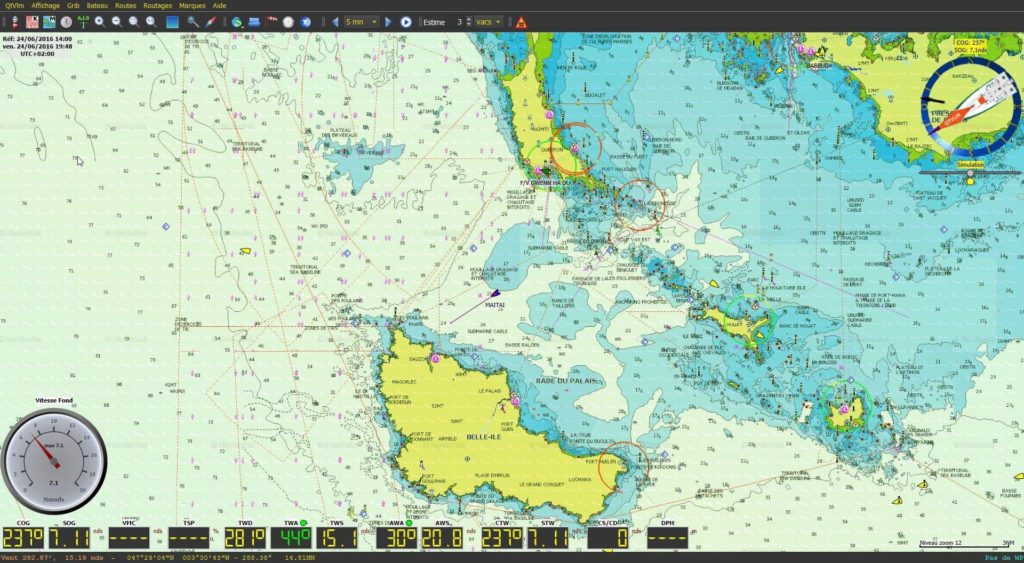
Where the name qtVlm for the navigation and weather routing software comes from is not known. In any case, qtVlm is worth a look for those who are looking for a freeware navigation software with basic functions. Depending on further wishes, the software can be expanded with add-ons that are subject to a fee. If you need it, you can also book telephone or email support for a fee. The software is available for the following operating systems:
- Linux PC
- Linux Raspi
- Mac
- Windows PC
- Android app
- Android wearables (smart watches)
Suitable maps are:
- Vector Maps (S57, S63)
- Raster maps (kaps, geotiff, mbtiles)
- Grib weather maps as an overlay
- Current data as an overlay
Functions:
- route routing
- weather routing
- Collision warning via AIS
- regatta features
- Display of sensor data
- Performance optimization with polar plot data
- NMEA multiplexer with input and output
qtVlm can process the following on signal sources:
- NMEA0183 In/Out over TCP/UDP
- NMEA0183 In/Out via USB, RS232
- AIS as NMEA0183
- GPSd over TCP
In addition to an integrated NMEA multiplexer, filter functions can also be defined for the respective signal sources. However, as with OpenCPN, operation is designed for desktop applications and requires a mouse and keyboard. In the Android app, many setting functions are optimized for touch operation.
This is what the makers of qtVlm say about their software:
| „Viele Optionen sind verfügbar, wie z. B. Multi-Routing, um das beste Datum und die beste Abfahrtszeit gemäß verschiedenen Parametern zu finden, Routing auf einem Weg oder die Berücksichtigung von Segmenten mit Motor. Winde, Strömungen und Wellen sowie einige andere Wettervariablen werden während der Berechnung verwendet. Bootsleistungen können sehr genau abgestimmt werden, zum Beispiel die polare Effizienz bei Nacht oder die Zeit, die zum Wenden oder Halsen benötigt wird. Es können mehrere Grib-Dateien gleichzeitig geladen werden, um mit verschiedenen Parametern (z. B. Wind, Strömung und Wellengang) routen zu können oder Grib-Modelle zu vergleichen. Wetterfaxbilder können auch auf Grids geladen werden. Ein Startlinienmodus verwaltet eine Regatta-Startlinie mit Chronometer, Entfernungs- und Zeitberechnungen und zeigt eine sichere Zone an. qtVlm kann auch im Simulationsmodus verwendet werden . In diesem Modus verwendet qtVlm Wind- und Strömungsdaten von grib, um die Navigation zu simulieren. Alle Instrumente sind nutzbar und echte Live-AIS-Ziele werden aus dem Internet empfangen. Achten Sie darauf, nicht mit einem echten Fischerboot oder einem anderen qtVlm-Boot zu kollidieren!“ |
Conclusion
Freeware is not the same as open source. Anyone looking for open source software for navigation applications is wrong with qtVlm. Nevertheless, it is worth taking a closer look at the program, as it offers a very extensive range of functions and some extras for regatta sailors and long-distance sailors. The good one deserves special mention English language documentation which describes in detail all functions of the program. The program is based on Qt and is therefore available for all common operating systems. However, the desktop versions require a mouse and keyboard and are intended more for applications at the card table. With the Android app, the program is also available for tablets and can therefore also be used directly at the helm. Using the NMEA Out function of the multiplexer, for example, server data can be forwarded from the Raspi to the Android app on the tablet. This means that the same data is available both at the chart table and at the helm station.
Link to website: https://www.meltemus.com/index.php/en/